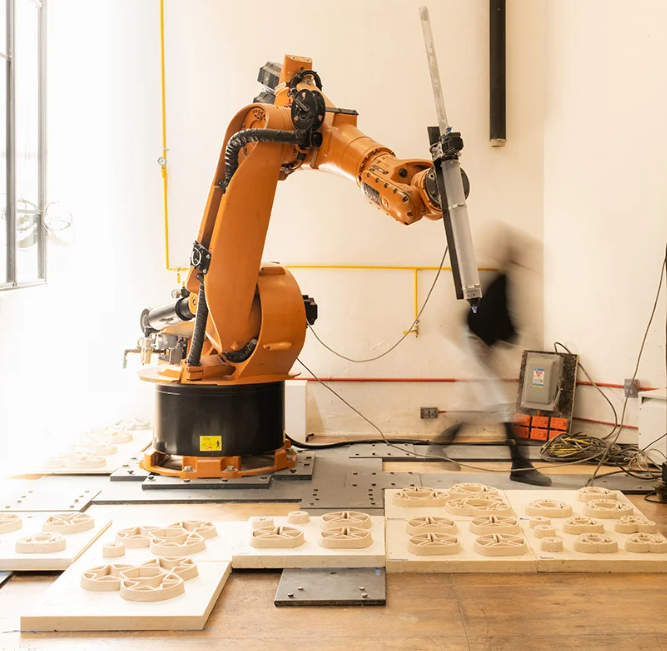Mexico-based company MANUFACTURA has led “The Eggshell Project” to convert organic waste into a building material, creating new opportunities to ground people’s lives in environmental protection.
The research project uses a KUKA KR-150 robotic arm to 3D print a bioceramic created from used eggshells and combines it with sustainable aggregates. The process, when completed, produces building blocks with various geometries which may be employed for a variety of architectural purposes. This new sustainable materiality aims to decrease Mexico’s ample organic and food waste while also developing fresh possibilities through technological advances and cultivating a “better dialogue between humans and machines”.
“Our process allows less waste production, geometrical freedom, precision, and repeatability,” explains the team at MANUFACTURA.
Why did Manufactura decide to take this approach?
The Eggshell Project starts with tackling two issues, namely, the harmful environmental impacts of the ceramics industry and Mexico’s excessive food waste and organic matter. MANUFACTURA recalls the environmental impact of ceramics processes, ranging from gas emissions from firing and fuels to waste disposal, energy usage, and transportation.
The design team minimized the process’s detrimental effect by employing a locally grown, widely found, and lightweight waste product like eggshells, reassessing the industry’s ability and preserving a connection between nature and materiality. The mixture, when combined with bio-binders, can solidify without the requirement of firing, which is further improved by an additive fabrication process focused on 3D printing with a robotic arm.
Using bioceramics for sustainable production
MANUFACTURA concentrated on developing materials in the research, generating two main applications, the Eggshell Bricks Wall, which is made up of 105 distinct blocks which are gathered depending on their geometry, and the Eggshell Column, which is made up of 26 parts that support one another and bring stability through their shape. Each brick is created in a 100% sustainable and circular process because the raw material was acquired through the donation of waste from different restaurants in Mexico over the course of two months of production.
This project was made possible by a combination of computational design and the possibilities provided by technology, digital manufacturing, and material advancement to convert waste and raise awareness. Finally, MANUFACTURA questions our manufacturing techniques and instead seeks to establish circular systems of production and living while also creating fresh opportunities for employment. Through its reprocessing, sanitizing, manufacturing, and site construction techniques, the “Eggshell Project process generates new opportunities,” says the company.

Sustainable 3D printing examples
Recently, as part of the G20 Summit initiatives, IIT Guwahati created a 3D printed security post out by employing M40-grade sustainable concrete that comprised industrial waste, fibers, and chemical additives. Under the guidance of Dr. Biranchi Panda, Assistant Professor, IIT Guwahati, the team of Dodda Srinivas, Dhrutiman Dey, and Akshay Sahu established Stratify 3D and developed this digital technology in correlation with India’s Prime Minister Narendra Modi’s ‘AatmaNirbhar Bharat‘ vision. This automated and “innovative technology” developed at IIT Guwahati is adequately prepared to provide customized homes in India with improved quality control and shorter lead times.
Furthermore, Frankfurt start-up Enable 3D and German DIY magazine Selber Machen collaboratively introduced the Print and Play Construction company collection. The designs were completely produced and displayed on a newly created recycled printing material developed by Amsterdam-based startup Reflow. The bioderived material used by Reflow is made from recycled food packaging and comes in an array of translucent colors. Users can download free product templates from the website and 3D printing platforms and print them using their own 3D printers.
What does the future of 3D printing for the next ten years hold?
What engineering challenges will need to be tackled in the additive manufacturing sector in the coming decade?
To stay up to date with the latest 3D printing news, don’t forget to subscribe to the 3D Printing Industry newsletter or follow us on Twitter, or like our page on Facebook.
While you’re here, why not subscribe to our Youtube channel? Featuring discussion, debriefs, video shorts, and webinar replays.
Are you looking for a job in the additive manufacturing industry? Visit 3D Printing Jobs for a selection of roles in the industry.
Featured image shows KUKA KR-150 robotic arm in MANUFACTURA’s atelier workshop. Image by Enrique Aguilar, MANUFACTURA.



